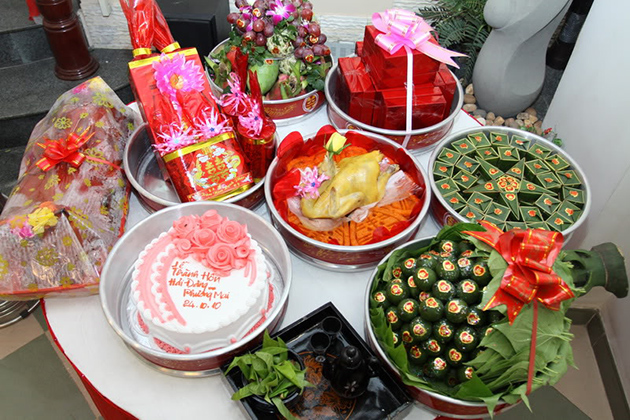No matter where you live, marriage seems always to be the most important ceremony in one person’s life. In the past, traditional weddings in Vietnam were rather complicated, including a lot of stages. Today, this custom is much simpler, however, it still keeps traditional characters. Some cumbersome rituals that are no longer suitable for modern life were discarded. Nevertheless, there are still compulsory rituals for couples which it’s so great if you have the opportunity to witness. Your Vietnam tour will be highlighted when once witness one of the most important ceremonies of Vietnam.
Betrothal Ceremony
This ritual happens before the wedding. Normally, the bride, the groom or their parents go to the fortuneteller first to ask for the “beautiful” date and time is the best choice for them. They strongly believe that if the ceremony is held on this date and time, everything will be good. After that, the groom’s family will come to the bride’s family with the lacquered boxes known as the betrothal presents. They include a lot of things: areca nuts, betel leaves, tea, cake, fruits, wines and many other offerings which are covered with red polish fabric and carried by single girls or boys. All of these young people, including both the bride and the groom, wear ao dai, usually in red – the lucky color of Vietnamese people.
Wedding Ceremony
The wedding ceremony is like the official announcement about the marriage of the young couple that the girl must leave her parents and follow her husband to live in his house and really become a married woman. On this day, the groom’s family, relatives, and friends together go to the bride’s house along with many presents wrapped in red papers that are similar to the ones in the betrothal ceremony. Women wear ao dai and men are in suits. The procession is often led by one person who is wealthy and successful in the parentage with the meaning of a blessing for the couple.
The betrothal procession will stop at the entrance of the bride’s house. The representative of the groom’s family will enter first with a wine tray in his hand. Afterward, two families sit down and sip a cup of tea. The groom’s side will introduce themselves and ask the bride’s family to allow their son to marry the bride. Later, the master of the wedding – a respected person in the bride’s parentage, will guide the bride’s parents to give their daughter. Then the bride steps out, following her parents. In tradition, she wears a red ao dai, but today, because of the modernity, it is replaced by a white dress which is the same as that in the western countries. The pair will stand to pray in front of the ancestor’s altar to ask for permission for their wedding, then keep their heads down and send their gratitude to the parents for bearing, bringing up and educating them.
Next, the master of the ceremony will give some useful advice about the family life that the couple soon will experience. Thereafter, the parents of the groom and bride, in turn, share their advice and give best wishes for the pair. The relatives and friends sit down, drink tea and eat cake, witnessing the wedding of the happy couple. Normally, some of them will go to the stage and sing sweet love songs or dance for having fun and congratulating the pair. Finally, the groom and the bride give the wedding rings for each other and receive the presents from their parents that usually is jewelry such as golden necklaces, rings, and bracelets…The ceremony finishes with a loud applause.
Banquet Party
Besides, along with the wedding, there is a big party at the groom and bride’s houses. Depending on many problems like the custom of each region, the time or something, it will be held before or after the wedding ceremony. It really has a huge scale with hundreds of tables. All of the friends, relatives, and neighbors of the groom and the bride are invited to this party. People often display from 7 to 10 dishes cooked from pork, chicken, beef, vegetables… The guests are expected to go with gifts (often money) to congratulate the groom and the bride. The couple also comes to each table to receive the blessings of the guests.
Today, most Vietnamese weddings are carried out according to both eastern and western styles. This is very easy to understand because all cultures always have integration. However, Vietnamese people still keep their own specific traditional values in this ceremony.



